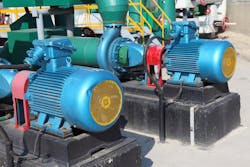Art. 430 provides the requirements for motors. But at a whopping 27 pages, it is the largest article in the National Electrical Code (NEC). From a technical standpoint, it is arguably the most complex as well. Most people who encounter Art. 430 for the first time find it dense and intimidating. However, if you take the time to study and understand Figure 430.1, you will find Art. 430 much easier to apply. Figure 430 is a roadmap that identifies each motor subsystem (e.g., motor disconnecting means) and the art of Art. 430 that applies to it (e.g., Part IX).
A great way to misuse Figure 430.1 is to jump right in and concern yourself with only the one part that applies to your particular task (for example, Part IX, which provides the requirements for the motor disconnecting means). This method can make you feel secure that you’ve got a code-compliant installation when that might not be the case.
You’ll notice that Figure 430.1 is not located before Part I, General Requirements, but in Part 1, General Requirements. In addition to providing the general requirements for all equipment covered by an article, the general requirements part of an article also serves the purpose of helping you to understand the article. That’s why you see things such as definitions in Part I of an article. So, Figure 430.1 is not a table of contents for Art. 430 (like the table of contents in the front of the NEC is for the NEC). It is a guide to help you apply Art. 430.
However, if you are installing a motor disconnecting means and totally comply with Part IX, how can you not have a code-compliant installation? Remember, the general requirements apply to all equipment, except where equipment is explicitly excluded from or covered by a requirement. There’s a lot of fertile ground for error if you skip the general requirements (430.1 through 430.18).
For example, you bring the conductors into the motor disconnecting means housing and terminate them. While you’re at it, you run branch circuit wiring through there for lights above the motor. But you’re unaware of the fact you can’t use the disconnect as a raceway or junction box [430.10(A)]. You are also unaware of the minimum wire bending space that applies to enclosures [430.10(B)] and, thus, have an enclosure that is too small.
That’s a couple of easy-to-make errors for Part IX. It can get a lot worse with other parts. For example, you do everything else right, but the location of the motor violates 430.14.
Some highlights from Part I:
- Use the ampacity tables per 310.15 to select motor circuit conductors, or calculate their size per 310.14(B) [430.6].
- Use the motor nameplate rating to determine separate motor overload protection [430.6(A)(3)].
- Need to unlock the locked rotor indicating code letters on the motor nameplate? Use Table 430.7(B).
- Ensure the motor has adequate ventilation [430.14(A)].
And here’s one of those “helping you to understand the article” things from Part I. If you’re going to size conductors that supply several motors, you have to sum up four kinds of data [430.24]. The first two require you to know the full-load current of each motor, but there’s no reference here to help you find that information. The reference is actually in Part I. It’s there instead of here because it applies to 430.53(B) and 430.53(C) as well.
You select the full-load current from Table 247, 248, 249, or 250 as applicable. The tables cover, respectively, direct-current motors, single-phase ac motors, two-phase ac motors (four-wire), and three-phase motors.
About the Author

Mark Lamendola
Mark is an expert in maintenance management, having racked up an impressive track record during his time working in the field. He also has extensive knowledge of, and practical expertise with, the National Electrical Code (NEC). Through his consulting business, he provides articles and training materials on electrical topics, specializing in making difficult subjects easy to understand and focusing on the practical aspects of electrical work.
Prior to starting his own business, Mark served as the Technical Editor on EC&M for six years, worked three years in nuclear maintenance, six years as a contract project engineer/project manager, three years as a systems engineer, and three years in plant maintenance management.
Mark earned an AAS degree from Rock Valley College, a BSEET from Columbia Pacific University, and an MBA from Lake Erie College. He’s also completed several related certifications over the years and even was formerly licensed as a Master Electrician. He is a Senior Member of the IEEE and past Chairman of the Kansas City Chapters of both the IEEE and the IEEE Computer Society. Mark also served as the program director for, a board member of, and webmaster of, the Midwest Chapter of the 7x24 Exchange. He has also held memberships with the following organizations: NETA, NFPA, International Association of Webmasters, and Institute of Certified Professional Managers.
